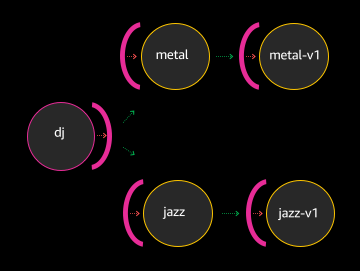Testing the Application
Now it’s time to test. Calls can be made to metal or jazz from within the dj pod and they are routed to either the metal-v1 or jazz-v1 endpoints, respectively.

To test if our ported DJ App is working as expected, we’ll first exec into the dj container.
export DJ_POD_NAME=$(kubectl get pods -n prod -l app=dj -o jsonpath='{.items[].metadata.name}')
kubectl -n prod exec -it ${DJ_POD_NAME} -c dj bash
You will see a prompt from within the dj container.
Test the confiuration by issuing a curl request to the virtual service jazz on port 9080, simulating what would happen if code running in the same pod made a request to the jazz backend:
curl -s jazz.prod.svc.cluster.local:9080 | json_pp
Output should be similar to:
Now test the metal service:
curl -s metal.prod.svc.cluster.local:9080 | json_pp
You should get a list of heavy metal bands back:
When you’re done exploring this vast, now mesh-enabled world of music, hit CTRL-D, or type exit to exit the container’s shell
Congrats! You’ve migrated the initial architecture to provide the same functionality, but now with the wide array of AWS App Mesh features at your disposal.
Let’s try out one of those features by adding a new version of the metal and jazz backend services, and adding some new configuration to our virtual routers to shift traffic between the different versions.